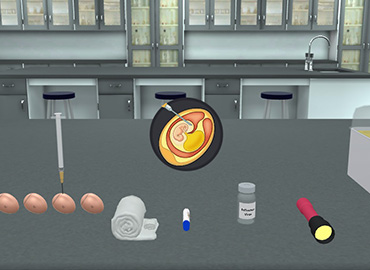Virus Simulator - Cultivation and Preparation of the Virus in Chick Embryo
Biology | Biochemistry | Genetics | Microbiology






2.5M+
Active Users Worldwide
80%
Improved Learning Retention
60%
Reduction in Laboratory Costs
The primary purpose of virus cultivation is to isolate and identify viruses in clinical samples; to do research on viral structure, replication, genetics and effects on host cell; to prepare viruses for vaccine production following a strict virus preparation protocol.
Cultivation and preparation of the virus in chick embryo: Fertile eggs are cleaned, dried, and rubbed with alcohol. 2. The date is recorded on each egg. 3. Eggs are incubated at 37 °C for 7-12 days. 4. Eggs are gently rocked daily. 5. Be sure of the growth of the embryo (beating heart) by examining the egg against a strong light in a dark chamber as shown in the virus simulator model. 6. Two points are marked on each egg under transillumination, one of them delimiting the air sac and the other opposite the semitransparent area in the neighborhood of the embryo. 7. The inoculum is introduced through an opening made in the shell using the egg shell puncher. 8. There are five main routes of virus inoculation using a syringe containing the virus: a. Into the chorioallantoic membrane. b. Into the amniotic cavity. c. Into the allantoic cavity. d. Into the yolk sac. e. Into the embryo itself. 9. After inoculation, the eggs are reincubated at 37oC for several days and examined daily in a virus virtual lab setting. 10. Virus growth is recognized by the development of: Plaques on the chorioallantoic membrane. Haemagglutinin in the amniotic or allantoic cavities. Death of the embryo (heart beats stop): just this will be shown in the experiment using a virus simulator.
Become proficient at performing the viral cultivation consistently and accurately.
Most of the viruses can be cultivated in:
Allantoic Cavity:
Chorioallantoic membrane:
The Primary Purpose of Virus Cultivation Is:




